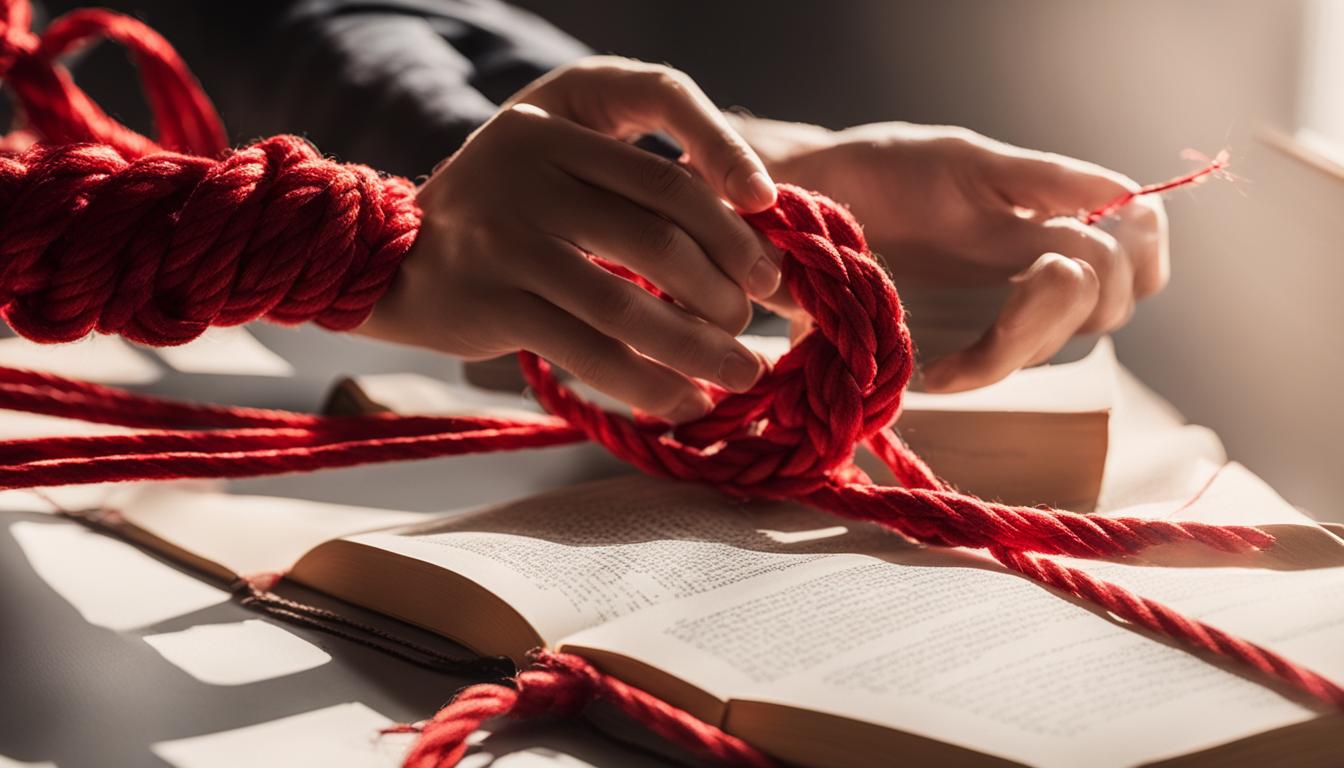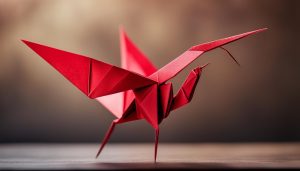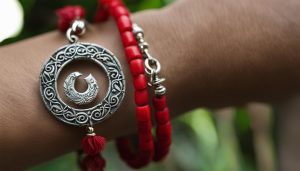Are you ready to learn how to hang the square good luck knot? This ancient Chinese knot carries powerful symbolism and is believed to bring good fortune. By following these simple instructions, you can easily create and hang your own square good luck knot for positive energy in your space.
Contents
Key Takeaways:
- The square good luck knot is a traditional Chinese knot that symbolizes good fortune.
- To hang the knot, you will need a one meter long paracord and follow a series of folding and looping steps.
- The square good luck knot can be made with a red paracord for enhanced effects.
- By hanging the square good luck knot, you can invite positive energy and luck into your life.
- Once you have mastered the art of hanging the square good luck knot, you can explore other types of Chinese knots and their significance.
The Significance of Chinese Knots
Chinese knots, also known as 中国结 in Chinese, have a deep-rooted significance in both Buddhist and Taoist traditions. These intricate knots symbolize the ultimate unity of everything, embodying principles of symmetry, balance, unity, and interconnections. Just like the Eternal Knot in Buddhism, Chinese knots are made with a single thread, are symmetrical in all directions, and have no distinctions between head and tail.
Traditionally, Chinese knots are believed to ward off evil spirits and bring good luck. They are commonly used to decorate homes during festivities and celebrations, adding a touch of auspiciousness to the atmosphere. Chinese knots are also widely incorporated into traditional jade jewelry, further enhancing their cultural significance and beauty.
Whether used as decorative symbols or worn as jewelry, Chinese knots carry a rich heritage and serve as a reminder of the profound unity present in the world. Through their intricate designs and symbolic meanings, Chinese knots reflect the timeless wisdom and aesthetics of Chinese culture.
The Symbolism of Chinese Knots
| Symbolism | Meaning |
|---|---|
| Eternal Unity | Reflects the interconnectedness of all things |
| Balance | Represents harmony and equilibrium |
| Good Luck | Believed to bring fortune and ward off evil spirits |
| Beauty | Exemplifies the elegance of Chinese aesthetics |
Chinese knots hold a special place in the hearts of those who appreciate the intricate beauty and profound symbolism they carry. Whether used as decorative accents or cherished as meaningful jewelry pieces, Chinese knots continue to captivate and inspire people around the world.
The History and Evolution of Chinese Knots
Chinese knots have a fascinating history that stretches back over two millennia. The art of Chinese knotting originated during the Zhou dynasty, around 1046-256 BCE, making it one of the oldest known knotting techniques in the world. Initially, Chinese knots were simple and used for practical purposes such as fastening clothes and securing objects.
However, as time went on, Chinese knotting evolved into a highly intricate and decorative craft. During the Ming dynasty (1368-1644), Chinese knots reached their peak of popularity and complexity. Elaborate knots adorned the clothing and accessories of the nobility, and large decorative knot displays became a common sight in homes and temples.
Chinese knotting techniques also spread beyond China’s borders during the Ming dynasty, influencing the knotting traditions of Japan and Korea. These neighboring countries developed their own unique styles of knotting while still maintaining the essence of Chinese knotting principles.
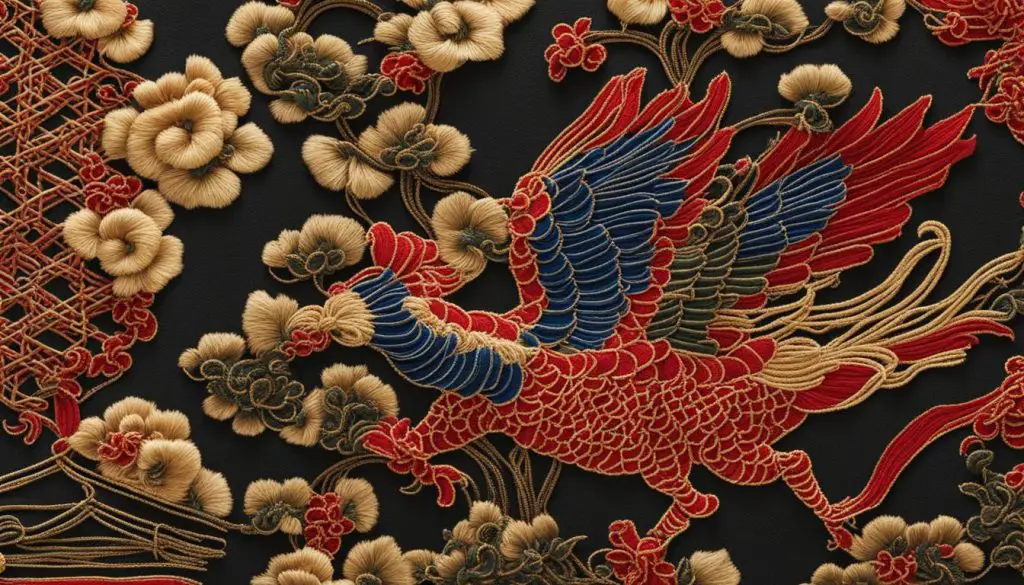
The art of Chinese knotting faced a decline during the Cultural Revolution in the 20th century when traditional crafts were suppressed. However, in recent years, there has been a revival of interest in Chinese knotting as people appreciate its cultural significance and intricate beauty. Today, Chinese knots are cherished as symbols of tradition, good luck, and craftsmanship.
The Evolution of Chinese Knotting
Over the centuries, Chinese knotting has evolved from simple fasteners to intricate decorative art forms. The craft has become more complex with the development of new knotting techniques and designs. Knots that were once used for functional purposes now grace jewelry, home decor, and even architectural elements.
Chinese knotting has also embraced modern influences, blending traditional techniques with contemporary materials and aesthetics. Knot artists experiment with different colors, textures, and forms to create unique and innovative designs.
Chinese Knots during the Ming Dynasty
The Ming dynasty was a golden age for Chinese knots, with the intricate designs reaching their peak of complexity and popularity. During this time, Chinese knots adorned clothing, accessories, and household items. They were also used to hang scrolls, swords, and other precious objects, symbolizing protection and good fortune.
| Types of Chinese Knots | Meanings |
|---|---|
| Cloverleaf Knot | A symbol of luck and fortune |
| Double Coin Knot | Associated with ancient coins used for predicting the future |
| Button Knot | Traditionally used as a functional button |
These intricate knots not only added beauty to everyday objects but also served as symbols of status and wealth. The complexity of the knots demonstrated the skill and artistry of the craftsmen who created them.
Today, the history and evolution of Chinese knots continue to inspire artisans, collectors, and enthusiasts worldwide. The intricate designs and cultural significance of Chinese knots make them timeless treasures that connect us to the rich heritage of ancient China.
Different Types of Chinese Knots
Chinese knots are known for their intricate designs and symbolic meanings. There are several different types of Chinese knots, each with its own unique charm and significance. Here are four popular types of Chinese knots:
The Cloverleaf Knot
The Cloverleaf Knot is a beloved symbol of luck and fortune. This knot features a symmetrical design that resembles a cloverleaf. It is often used in decorative items and accessories as a way to invite good luck into one’s life. The Cloverleaf Knot is a beautiful representation of the positive energy and prosperity that Chinese knots are associated with.
The Buddha Knot
The Buddha Knot takes inspiration from the Swastika symbol and represents enlightenment. It is a knot that symbolizes the pursuit of wisdom and spiritual growth. The intricate design of the Buddha Knot is a reflection of the deep-rooted Buddhist tradition in Chinese culture. This knot is often used in Buddhist ceremonies and can be found on various auspicious items, such as pendants and prayer beads.
The Chinese Button Knot
The Chinese Button Knot is not only beautiful but also functional. As its name suggests, it was traditionally used as a decorative button on clothing. This knot consists of a series of loops and twists that create a disc-like shape. The Chinese Button Knot is not only visually appealing but also serves as a practical closure for garments. It is an excellent example of how Chinese knots combine aesthetics with functionality.
The Double Coin Knot
The Double Coin Knot is associated with ancient Chinese coins, which were used for predicting the future and warding off evil spirits. This knot features two intertwined loops that resemble ancient coins. It is often used in jewelry and accessories as a symbol of wealth and prosperity. The Double Coin Knot is a popular choice for those seeking to attract good fortune and financial success.
Each of these Chinese knots has its own unique design and symbolism. Whether you’re attracted to the luck and fortune of the Cloverleaf Knot or the spiritual significance of the Buddha Knot, Chinese knots are a beautiful way to incorporate tradition and symbolism into your life.
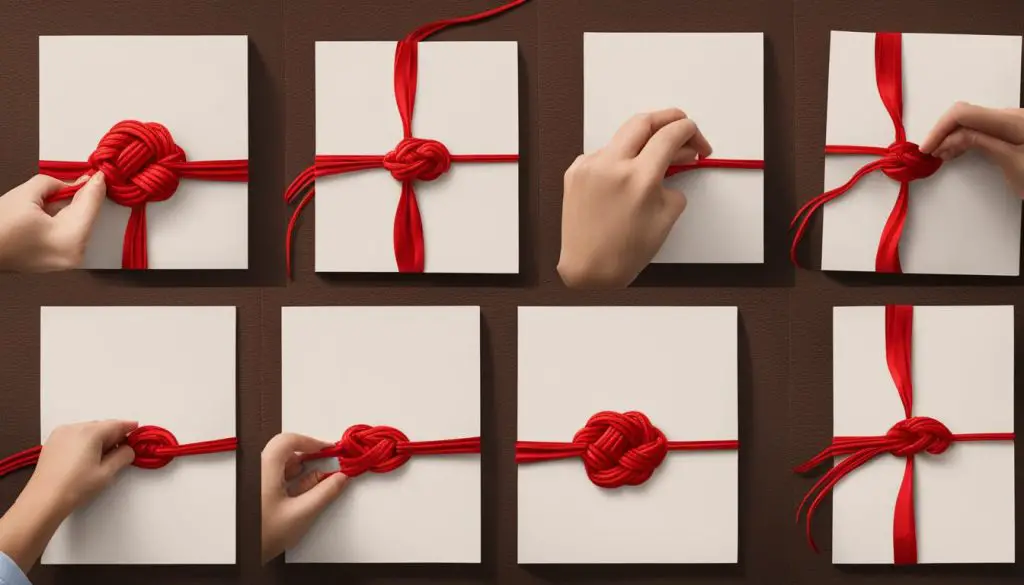
| Chinese Knot | Meaning |
|---|---|
| Cloverleaf Knot | Luck and fortune |
| Buddha Knot | Enlightenment |
| Chinese Button Knot | Functionality and aesthetics |
| Double Coin Knot | Wealth and prosperity |
How to Tie a Square Knot in Macrame
If you’re interested in macrame, learning how to tie a Square Knot is an essential skill to master. The Square Knot is a binding knot that is widely used in macrame projects to join two pieces of cord or rope together. It’s a simple yet versatile knot that forms the basis for many intricate designs.
Here’s a step-by-step guide on how to tie a Square Knot:
- Start with two cords placed horizontally. The left cord should be positioned over the right cord.
- Take the left cord and cross it over the right cord.
- Pass the left cord under the right cord and through the loop created by the two cords.
- Tighten the knot by pulling both cords in opposite directions.
- Repeat the above steps to create additional Square Knots.
By repeating these simple steps, you can create beautiful macrame designs such as wall hangings, plant hangers, bracelets, and more.
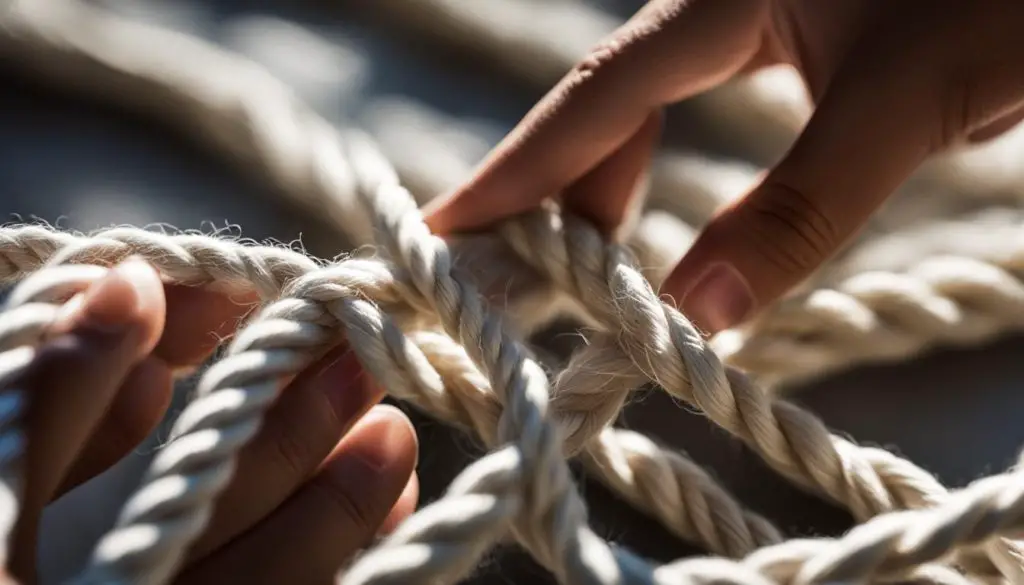
Variations of Square Knots
The Square Knot can be modified and combined with other knots to create a variety of interesting variations. Some popular variations of the Square Knot include:
- Caged Solomon Bar
- Secret River Bar
- Wave Knot
- Switch Knot
Each variation adds its own unique flair to macrame projects, allowing you to unleash your creativity and create stunning pieces.
Table: Materials Needed for Tying Square Knots
| Materials | Description |
|---|---|
| Cord or Rope | Choose a suitable cord or rope material that is strong and durable, such as cotton or nylon. |
| Scissors | A sharp pair of scissors is necessary for cutting the cord or rope to the desired length. |
| Tape Measure | Use a tape measure to accurately measure the length of the cord needed for your macrame project. |
| Clipboard or Macrame Board | A clipboard or macrame board can provide a stable surface to work on and keep your cords organized. |
With the right materials and a little practice, you’ll be able to tie Square Knots with ease and create stunning macrame creations.
Projects using Square Knots in Macrame
Macrame is a versatile and creative craft that allows you to create stunning pieces using various knotting techniques. One popular knot used in macrame is the Square Knot. This simple yet impactful knot can be used to make a variety of projects, adding a touch of bohemian charm to your home or wardrobe.

One of the most popular projects you can make with Square Knots is a Plant Hanger. By tying a series of Square Knots and incorporating beads or other decorative elements, you can create a stylish hanger to display your favorite indoor plants. Not only does this project add a touch of greenery to your space, but it also adds texture and visual interest.
Another project that can be made with Square Knots is a Bracelet. By using a combination of Square Knots and adding some embellishments such as beads or charms, you can create a unique and personalized accessory. Whether you prefer a simple and minimalistic design or a more intricate and colorful one, the possibilities are endless with Square Knot bracelets.
If you’re looking for a functional and decorative project, consider making a Coaster Set using Square Knots. By alternating Square Knots with other knotting techniques or adding different colors of cord, you can create coasters that not only protect your surfaces but also add a stylish touch to your home decor.
For beginners or those looking for a quick and easy project, a Simple Macrame Bookmark is a great choice. Using Square Knots, you can create a bookmark with tassels that not only holds your place in a book but also adds a touch of handmade charm. This project is a perfect introduction to macrame and can be made with just a few basic supplies.
Conclusion
Learning how to hang the square good luck knot and tie Square Knots in macrame can have a significant impact on your creativity and cultural understanding. Chinese knots, with their rich history and symbolism of unity, balance, and good luck, bring a touch of tradition and positive energy into your life. By incorporating Square Knots in macrame, you can create beautiful and functional projects that add a personal touch to your home.
Understanding the significance of Chinese knots and Square Knots in macrame allows you to appreciate the artistry and craftsmanship behind these techniques. Chinese knots, with their deep-rooted meanings and aesthetic principles, provide a window into Chinese culture and philosophy. Meanwhile, Square Knots in macrame offer endless possibilities for creating unique and intricate designs that showcase your artistic expression.
By learning these techniques, you not only gain new skills but also a connection to a rich cultural heritage. Whether you’re hanging the square good luck knot or creating macrame projects, the importance lies in the journey of exploration and self-expression. So embrace the world of Chinese knotting and macrame, and let your creativity soar while enjoying the satisfaction of making something meaningful and beautiful.
FAQ
How do I hang the square good luck knot?
To hang the square good luck knot, you will need a one meter long paracord, preferably in red for the best effects. Start by folding the paracord in half and locating the top loop at the center. Make the right and left loops, folding the bottom strand and the left loop over the right loop. Draw the knot together by tugging on all the loops and strands, creating a square shape in the middle. Fold the left loop over the bottom loop and the bottom loop over both loops on the right side. Fold the longer right loop over the top loop and the loose strands. Finally, fold the two loose strands over the left loop and through the hole that was kept open. Draw the knot together by pulling all the loops and strands outwards. Congratulations, you have successfully hung the square good luck knot!
What is the significance of Chinese knots?
Chinese knots, also known as 中国结 in Chinese, have a deep-rooted significance in Buddhist and Taoist tradition. They symbolize the ultimate unity of everything, just like the Eternal Knot in Buddhism. Chinese knots embody the principles of symmetry, balance, unity, and interconnections, which are fundamental in Chinese aesthetics and philosophy. They are believed to ward off evil spirits and bring good luck. Chinese knots are used to decorate homes during festivities and celebrations and are commonly found in traditional jade jewelry.
What is the history of Chinese knots?
Chinese knots have a long history that dates back to at least 500 years before Buddhism, during the Zhou dynasty. Over time, the craft of Chinese knotting became more sophisticated, with elaborate knots being used to decorate robes, jewelry, and even hang swords and scrolls. Chinese knotting spread to Japan and Korea during the Ming Dynasty, where it developed into its own traditions with local characteristics. The art of Chinese knotting saw a revival in recent years after almost disappearing during the Cultural Revolution. Today, Chinese knots are widely appreciated for their beauty and are used as decorative symbols of good luck and fortune.
What are the different types of Chinese knots?
Chinese knots come in various types, each with its own unique design and meaning. Some popular types include the Cloverleaf Knot, which is a symbol of luck and fortune; the Buddha Knot, inspired by the Swastika symbol and representing enlightenment; the Chinese Button Knot, traditionally used as a functional button; and the Double Coin Knot, which is associated with ancient coins used for predicting the future and warding off evil spirits. These knots showcase the intricacy and beauty of Chinese knotting techniques.
How do I tie a Square Knot in macrame?
The Square Knot is a binding knot commonly used in macrame to join two pieces of cord or rope. To tie a Square Knot, fold the cords in half and follow a series of steps that involve crossing the outer left cord over to the right, placing the outer right cord over the left, and pulling the outer right cord behind the two inner cords through the loop made by the outer left cord. Repeat these steps to complete the Square Knot. Square Knots can be modified and combined with other knots to create more intricate designs. Variations of the Square Knot include the Caged Solomon Bar, Secret River Bar, Wave Knot, and Switch Knot.
What projects can I create using Square Knots in macrame?
Square Knots are versatile and can be used to create a variety of macrame projects. Some popular projects include the Plant Hanger, which features a series of alternating Square Knots and can make a statement piece in any room; the Bracelet, made by tying a series of Square Knots and tightening them to create a snug fit; the Coaster Set, which uses alternating Square Knots to create decorative and functional coasters; and the Simple Macrame Bookmark, a beginner-friendly project that uses Square Knots to create a bookmark with tassels. These projects showcase the beauty and creativity that can be achieved with Square Knots in macrame.

